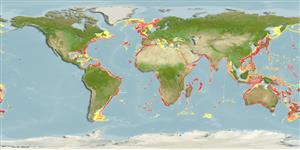Preferred temperature (Ref.
123201): 4.5 - 15.9, mean 10.3 °C (based on 1342 cells).
Phylogenetic diversity index (Ref.
82804): PD
50 = 0.5000 [Uniqueness, from 0.5 = low to 2.0 = high].
Bayesian length-weight: a=0.01122 (0.00830 - 0.01517), b=3.05 (2.96 - 3.14), in cm total length, based on LWR estimates for this species (Ref.
93245).
Nível Trófico (Ref.
69278): 3.5 ±0.53 se; based on food items.
Generation time: 11.9 ( na - na) years. Estimated as median ln(3)/K based on 1
growth studies.
Resiliência (Ref.
120179): Baixo, tempo mínimo de duplicação da população 4,5 - 14 anos (K=0.11; tmax=11).
Fishing Vulnerability (Ref.
59153): High to very high vulnerability (67 of 100).
Climate Vulnerability (Ref.
125649): Low vulnerability (7 of 100).
Nutrients (Ref.
124155): Calcium = 36 [14, 170] mg/100g; Iron = 0.667 [0.323, 1.472] mg/100g; Protein = 17.1 [15.7, 18.4] %; Omega3 = 0.347 [0.140, 0.941] g/100g; Selenium = 51.9 [22.6, 114.4] μg/100g; VitaminA = 15.4 [3.6, 73.8] μg/100g; Zinc = 0.714 [0.457, 1.152] mg/100g (wet weight);
